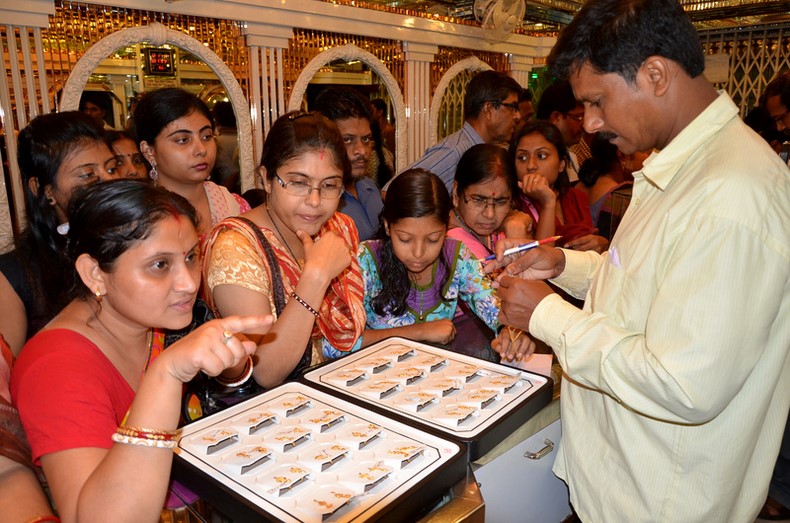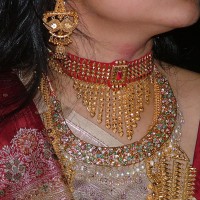
Earlier this year, the price of gold fell considerably in India, prompting people in large numbers to rush to shops to buy the precious metal. Image by Sanjoy Karmakar. Copyright Demotix (18/4/2013)
The southwestern Indian state of Kerala has an unparalleled hunger for gold. Nicknamed “gold's own country” by the New York Times last year, the state counts for only 3 percent of the population in India, but consumes 20 percent of the country's gold every year. Some of the largest gold showrooms in Asia are found in Kerala. Newborn babies here are fed gold dust and honey as a tradition. Brides are commonly draped from head to toe in gold.
That's why Indian movie actress Rima Kallingal, who is from Kerala, recently made waves when she married in a simple ceremony sans the precious metal. At a time when many of her fellow film stars often appear as brand ambassadors to jewelry shops, her decision made a statement.
She explained her reasoning on Facebook:
പ്രിയരെ, നവംബർ ഒന്നാം തിയതി, കേരളപിറവി ദിനത്തിൽ ഞങ്ങൾ വിവാഹിതരാവുന്ന വിവരം സസന്തോഷം അറിയിക്കട്ടെ. ഞങളുടെ മാതാപിതാക്കളുടെയും സുഹൃത്തുക്കളുടെയും സാനിദ്ധ്യത്തിൽ എറണകുളം കാക്കനാട് രെജിസ്ട്രാർ ഓഫീസിൽ ഒരു രജിസ്റ്റർ വിവാഹത്തിൽ ഒതുങ്ങും ചടങ്ങുകൾ. ബന്ധുക്കളേയും, സഹപ്രവർത്തകരെയും, സുഹൃത്തുക്കളേയും, മാധ്യമപ്രവർത്തകരേയും ക്ഷണിച്ച് വിരുന്ന് നൽകേണ്ട നാട്ടുനടപ്പുണ്ട് എങ്കിലും, തല്ക്കാലം ആ ചിലവുകൾ ഒഴിവാക്കി നിങ്ങളുടെ എല്ലാവരുടെയും പേരിൽ വിവാഹ ചിലവുകൾകായുള്ള പണം എറണകുളം സർകാർ ആശുപത്രിയിൽ അർബുദ രോഗത്തോടു മല്ലിടുന്ന സാധാരണക്കാരായ രോഗികളുടെ ചികിത്സക് വേണ്ടി കൊടുക്കുകയാണ്. ഈ തുക ഞങളുടെ രണ്ടുപേരുടെയും സിനിമയിൽ നിന്നുള്ള വരുമാനമാണ്. എല്ലാവരുടെയും സ്നേഹത്തിനും പിന്തുണക്കും നന്ദി പറയന്നു. എം പി. പി രാജീവിനോടും, എറണകുളം ജനറൽ ആശുപത്രിയിലെ ഡോക്റെര്മാരോടും, അതോടൊപ്പം ഞങളുടെ മനസറിഞ്ഞ് കൂടെ നിന്ന മാതാപിതാക്കളോടും സുഹൃത്തുക്കളോടും പ്രത്യേകം നന്ദി അറിയിക്കുന്നു.
സ്നേഹത്തോടെ -
റിമ കല്ലിങ്കൽ, ആഷിഖ് അബു
Today, if my grandmother were alive, she would have been ecstatic to see me as a bride, but at the same time heartbroken to see me not dressed in gold from head to toe! From a very young age, I knew that I didn't want to wear so much gold for my marriage… For aesthetic reasons…
But as I grew up, the feeling grew stronger on many other levels, and today when I am getting married, I want to use this beautiful life that I have and this amazing platform that cinema has given me to send out my strong vote of protest against the dowry system that we still shamelessly and silently follow and dedicate my decision to the millions of parents who have spent their life earnings on their children's weddings!
Today, I won't be wearing a single gram of gold :)
Kerala's long history of gold
History has well documented the gold craze of many civilizations and cultures. Pharaohs, kings, emperors, and the so-called 49s of the American West all had a taste for the precious metal.
India's love for gold is much more than just investment. It has an emotional, cultural, religious and socio-political angle to it. India's love for this yellow metal dates back over 4,000 years when people of the Indus Valley first incorporated gold into jewelry. It also has a history of survival; gold was something one could keep as a reserve and could be passed on easily without any bureaucratic interference. Millions of people in India have invested in businesses or securities by pledging their gold jewelry.
People's attachment to the precious metal runs deep. Were it not for gold, the average Indian’s lot through history could have been a lot worse. That's why the story of Nirupama, a 9-year-old girl who gave up all her gold jewelry to benefit the struggle for freedom against the British in 1934 when India was still under colonial rule is still powerful.
Kerala's history with gold began when Romans traded the metal for spices. Today, more than 200,000 people in Kerala work in the gold industry, and the state is said to have more than 5,000 retailers.
Some of the more visible evidence of this gold obsession can be seen at weddings, where brides wearing so much of the precious metal that the weight of it all can make it harder to move about gracefully are a common sight.
‘Dowry is not just about gold’
Even though it is illegal, dowry (wealth transferred from bride's family to groom and groom's family) is not an uncommon feature of life in Kerala, though the fashion of brides wearing gold ornaments on their wedding day isn't necessarily part of the dowry custom. With the rise of dowry-related violence and deaths in India over the last decade, the tradition is a cause for concern.
Many social media users were elated at actress Rima Kallingal's decision not to wear gold during her wedding as a statement against the dowry system.
Siya Siyaa, a woman who lives in Dubai, said she would try to pass on Kallingal's same values to her children:
Lv u reema… if it was now (my marriage) i wuld hav takn same stand.. nw i can try to instill these views in my offsprings… :)
Blogan pondered on his blog why media didn't give the actress much attention on the issue:
ഒരു ജനതയുടെ സ്വര്ണ്ണ ഭ്രമത്തെ ഒരു പെണ്ണ് സ്വന്തം വിവാഹം കൊണ്ട് വെല്ലുവിളിച്ചപ്പോള് അത് ചര്ച്ച ചെയ്യാന്, ഇരുണ്ട ‘സ്വര്ണ്ണ മനസ്സുകളിലേക്ക്’ ഒരു നുറുങ്ങുവെട്ടമെങ്കിലും പകരാന് അവസരം വന്നപ്പോള് ‘സാമൂഹ്യ പ്രതിബദ്ധത’ മുഖ മുദ്രയാക്കി എഴുതിച്ചേര്ത്ത മാധ്യമ പന്നന്മാരൊന്നും മുന്നോട്ട് വന്നില്ല ,
അരക്ക് താഴേക്ക് അഭിരമിക്കാന് ഒന്നുമില്ലാത്ത സ്ത്രീവിഷയങ്ങള് ആര്ക്കുവേണം?
സഞ്ചരിക്കുന്ന ജ്വല്ലറികളായിക്കൊണ്ട് കല്യാണ മണ്ഡപത്തിലേക്ക് കയറിയ ചില നടിമാരുടെ വിവാഹങ്ങള് ഇതേ മാധ്യമങ്ങള് ആര്ഭാടമാക്കിയിരുന്നു എന്നുകൂടി ഓര്ക്കുക.
A culture that's gold crazy should be ashamed that we didn't give much attention to Rima's stance, and the media never cared to discuss it given they salivate over every pompous wedding of the rich and famous. When every sexually exploited case is discussed to death, such a great gesture by a woman was not given any air time
A blogger only known as Film Critic wrote:
കല്യാണ ദിവസം തിരഞ്ഞെടുക്കുന്ന കാര്യം തൊട്ട് ആഷിക് – റീമ ജോടികള് മലയാളിത്തവും , ലാളിത്യവും ഒരുപോലെ കാത്തുസൂക്ഷിച്ചു . എല്ലാ മതസ്ഥരും രഹസ്യമായി നാളും , മുഹൂര്ത്തവും നോക്കുന്ന ഇക്കാലത്ത് , മലയാളിത്തവും , കേരളീയതയും വാചകക്കസര്ത്തുകള് മാത്രമാകുന്ന ഇക്കാലത്ത് , കേരളപ്പിറവി ദിനത്തില് മുഹൂര്ത്തത്തിന്റെ തീട്ടൂരങ്ങളില്ലാതെ രണ്ടു റോസാപുഷ്പാലംകൃതമായ മാലകള് പരസ്പരം അണിയിച്ച് ലളിതമായി അവര് വിവാഹിതരായപ്പോള് കാലാകാലങ്ങളായി നിലനില്ക്കുന്ന പല മാമൂലുകളും തകര്ന്നു വീണു .
I have many reservations about Rima and [husband] Ashiq, however they really walked the talk. With just simple rose garlands, they held a simple ceremony, which is a tremendously positive thing.
However, not all users were as delighted by the actress’ comments.
Resmi Vava, a research student at IISER-P, wrote on her Google Plus account:
സ്ത്രീധനമെന്നാല് സ്വര്ണ്ണമെന്നു നിസ്സാരവത്കരിക്കുന്നതിനോടു യോജിപ്പില്ല എങ്കിലും..
Dowry is not just about gold, that's an oversimplification of the issue and I have reservations towards it. Yet, the views are interesting.
Sreebitha P. V., an assistant professor at the Central Univeristy of Karnataka, took an interesting position on the website Round Table India:
So it was not aesthetic reasons which prevented me from wearing gold. It was just that I was born in such socio-economic circumstances.
In fact, it is very easy for upper caste and upper class women like Rima to take a decision of not wearing gold for their marriage and to contribute lakhs for other causes. What about the OBCs and Dalits who cannot manage to wear gold even when they wish to do so, especially in the socio-cultural context of Kerala where gold symbolises social status! What about OBCs and Dalits who think that it is their right to gain this status by wearing gold? What about OBCs and Dalits who hopelessly believe that they can confront the casteist patriarchy by wearing gold?
Sreebitha also references the “Kallumala samaram” (stone necklace revolt) that took place in Kanjaveli, near Kollam in Kerala, where women of the lower (Pulaya caste) had to fight against the upper caste to wear gold and stones.
When Indians still struggle with poor governance and a lacking social security net, and when rural areas still lack a good banking system, an investment they can even wear that brings with it the possibility of upward social mobility will remain the precious metal of choice.









4 comments
No personal reasons behind the decision of not to wear gold for the auspicious occasion of my life ..I just wanna show it is not impossible..I have been against for such show offs throughout my life.., you can take it as a protest against the gold crazy culture or dowry system.
People do appreciate such efforts, but never set a model, instead blame the society and excuse that they are helpless..I didnt want to do something which hurt my identity especially on the big day of my life..and grateful to those who supported my decision without questioning it and accepted me as I am..
Rima is from higher class but castewise she is infact half obc (ezhava)and half dalit.
How?
How it was she is cristian